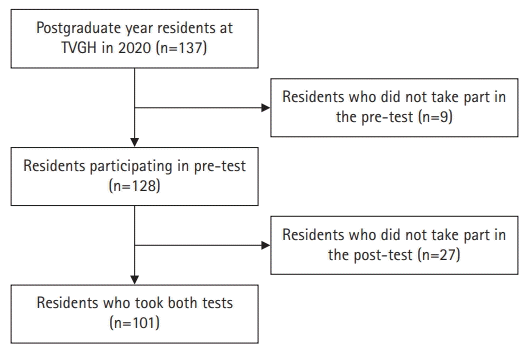Main results
The baseline characteristics of the participants are shown in
Table 1. Data from 101 PGY residents were available for analysis, with 78 participants educated through the new curriculum in university and the other 23 participants educated through the previous one. Participants’ ages ranged from 24 to 38 years old (median [IQR], 26 [2]); 65 (64.36%) of them were men, and 55 (54.46%) had graduated from public universities. The participants’ academic performance at university was divided into 4 groups based on quartiles. Out of 101 participants, 72 (71.28%) had grades in the top 50% of their universities. There were no significant differences in gender and university attended between the 2 groups that were educated in the new and previous medical education programs. Participants who were educated in the previous system were generally older than those who were educated in the new system (median [IQR], 27 [1] vs. 25 [1]; P<0.001). Regarding academic performance, participants educated in the new system had significantly higher scores at university (P=0.032).
Table 2 presents the pre- and post-test scores of OSCEs for the 2 groups that learned in different educational programs. In the pre-test, examinees who were educated in the new system scored higher (median [IQR], 50 [15]) in clinical reasoning than those who were educated in the previous system (median [IQR], 40 [10]; P<0.001). There was no significant difference between the 2 groups in terms of communication and procedural skills. For the total scores of the 3 stations, examinees who were educated in the new system scored significantly higher than those who were educated in the previous system (median [IQR], 199.59 [33.75] vs. 182.5 [25]; P=0.019). In the post-test, examinees who learned in the new educational program only scored higher in “history taking,” an item that assesses clinical reasoning (median [IQR], 25 [10] vs. 20 [10]; P=0.033). No differences were observed in communication skills, procedural skills, or total scores on the post-test.
The post-test results of both groups in all 3 stations showed significant improvements compared to the pre-test (all P<0.05). The improvement percentages of the 3 stations are shown in
Fig. 2. In clinical reasoning (
Fig. 2A), the improvement percentages of the students who learned in the previous educational program were significantly greater than those of the students who learned in the new program (median [IQR], 88.89% [115.87%] vs. 57.78% [65%]; P=0.017). In terms of communication skills (
Fig. 2B), procedural skills (
Fig. 2C), and the total scores of the 3 stations, the students educated in the previous system tended to improve more than those educated in the new system, but these differences did not reach statistical significance.
In addition to analyzing the effects of different education programs on OSCE performance, we also assessed the effects of other factors, including age, gender, university attended, and academic performance, on OSCE performance. For age, no differences were seen in the 3 stations in either the pre- or post-test.
On the pre-test, male participants outperformed female participants in communication skills (median [IQR], 75 [15] vs. 70 [8.75]; P=0.005). Clinical reasoning and procedural skills on the pre-test showed no significant differences according to gender. Further, the 3 stations tested on the post-test revealed no significance for gender. As for the improvement rate of post-test scores in the 3 stations and the total scores, there was no significant difference between men and women.
In terms of university attended, whether students attended a public or private medical school had no effect on their OSCE scores in the pre- or post-test. In academic achievement, interestingly, participants with lower scores in university had better performance in procedural skills on the pre-test (median [IQR], 87.5 [39.58] in the bottom quarter; 79.17 [27.08] in the lower middle quarter; 79.17 [20.83] in the upper middle quarter; and 62.5 [39.58] in the top quarter; P=0.008). However, participants with higher scores in university performed better in clinical reasoning on the pre-test (median [IQR], 50 [17.5] in the top quarter vs. 40 [25] in the bottom quarter; P=0.017). On the post-test, there were no significant differences in the OSCE scores among the 4 groups with different academic performances. As for the improvement percentage, participants in the top quarter had a higher improvement rate in procedural skills (median [IQR], 28.58% [122.60%] in the top quarter; 0% [29.28%] in the upper middle quarter; 0% [31.05%] in the lower middle quarter; and 0% [50.94%] in the bottom quarter; P=0.006). There was no significant difference among the 4 groups in the improvement rates of clinical reasoning, communication skills, and the total scores of the 3 stations.





 PDF
PDF Citation
Citation Print
Print





 XML Download
XML Download